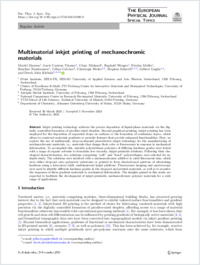Multimaterial inkjet printing of mechanochromic materials
DOKPE
- Mauron, Muriel University of Applied Sciences and Arts Western Switzerland, Fribourg, Switzerland
- Castens Vitanov, Lucie University of Applied Sciences and Arts Western Switzerland, Fribourg, Switzerland
- Michaud, César University of Applied Sciences and Arts Western Switzerland, Fribourg, Switzerland
- Wenger, Raphaël University of Applied Sciences and Arts Western Switzerland, Fribourg, Switzerland
- Muller, Nicolas University of Applied Sciences and Arts Western Switzerland, Fribourg, Switzerland
- Nussbaumer, Roseline University of Applied Sciences and Arts Western Switzerland, Fribourg, Switzerland
- Calvino, Céline University of Fribourg
- Weder, Christophe ORCID University of Fribourg
- Schrettl , Stephen University of Fribourg
- Gugler, Gilbert University of Applied Sciences and Arts Western Switzerland, Fribourg, Switzerland
- Kiebala, Derek John ORCID University of Fribourg
- 2024
Published in:
- The European Physical Journal Special Topics. - London, UK : Springer Nature. - 2024, p. 1-11
inkjet printing
multimaterial jetting
mechanochromic materials
functional surfaces
hardness gradient
English
Inkjet printing technology achieves the precise deposition of liquid-phase materials via the digitally controlled formation of picoliter-sized droplets. Beyond graphical printing, inkjet printing has been employed for the deposition of separated drops on surfaces or the formation of continuous layers, which allows to construct materials gradients or periodic features that provide enhanced functionalities. Here, we explore the use of multinozzle, drop-on-demand piezoelectric inkjet technology for the manufacturing of mechanochromic materials, i.e., materials that change their color or fluorescence in response to mechanical deformation. To accomplish this, suitable polyurethane polymers of differing hardness grades were tested with a range of organic solvents to formulate low-viscosity, inkjet-printable solutions. Following their rheological characterization, two solutions comprising “soft” and “hard” polyurethanes were selected for in-depth study. The solutions were imbibed with a mechanochromic additive to yield fluorescent inks, which were either dropcast onto polymeric substrates or printed to form checkerboard patterns of alternating hardness using a laboratory-built, multimaterial inkjet platform. Fluorescence imaging and spectroscopy were used to identify different hardness grades in the dropcast and printed materials, as well as to monitor the responses of these gradient materials to mechanical deformation. The insights gained in this study are expected to facilitate the development of inkjet-printable, mechanochromic polymer materials for a wide range of applications.
- Faculty
- Faculté des sciences et de médecine
- Department
- AMI - Chimie des polymères et matériaux
- Language
-
- English
- Classification
- Chemistry
- License
- Open access status
- hybrid
- Identifiers
-
- DOI 10.1140/epjs/s11734-024-01396-9
- ISSN 1951-6355
- Persistent URL
- https://folia.unifr.ch/unifr/documents/330412
Statistics
Document views: 45
File downloads:
- mauron-et-al_epjst-ms: 78
